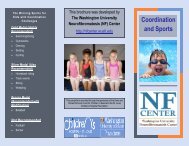TALKING ABOUT NEUROFIBROMATOSIS: A GUIDE FOR TEENS
TALKING ABOUT NEUROFIBROMATOSIS: A GUIDE FOR TEENS
TALKING ABOUT NEUROFIBROMATOSIS: A GUIDE FOR TEENS
You also want an ePaper? Increase the reach of your titles
YUMPU automatically turns print PDFs into web optimized ePapers that Google loves.
4<br />
Features of NF<br />
The most common feature seen in NF1 is the flat, tan birthmarks that you<br />
have on your skin. They are called cafè-au-lait spots, which is just a fancy<br />
French term referring to the light coffee color of the spots. They don’t cause<br />
any medical problems. Some people may have six spots and others may<br />
have 20; but having more spots doesn’t mean that you have a “worse”<br />
case of NF1. You won’t keep getting more spots throughout your life,<br />
either. Most people have all the spots they will ever have by the time they<br />
are five years old.<br />
Most people with NF1 develop freckles in their armpits or groin (the<br />
crease where your leg meets your body). These freckles are helpful in<br />
making the diagnosis of NF1 but don’t cause any medical problems. They<br />
usually develop during elementary school.<br />
Lisch nodules are freckles on your iris (the colored part of your eye).<br />
They don’t affect your eyesight in any way but they are important for<br />
diagnosing NF1. Nearly all people with NF1 will develop Lisch nodules<br />
by the time they are adults.<br />
The “neuro” in neurofibromatosis refers to the body’s nerves. People<br />
with NF1 can develop bumps on the nerves called neurofibromas.<br />
Neurofibromas look like lumps on or under the skin. They can grow any<br />
place where there are nerves — on the face, scalp, chest, as well as<br />
inside the body.<br />
Neurofibromas often start to show up during puberty. They may keep<br />
getting bigger for a while but will eventually stop growing. Typically,<br />
people gradually develop new ones as they get older. There is no way to<br />
predict how many neurofibromas someone will develop. Neurofibromas<br />
usually don’t hurt but are sometimes tender if they are irritated by<br />
something rubbing on them, like a shoe or waistband. Doctors may<br />
sometimes call them a tumor, but they aren’t a cancer and won’t turn into<br />
a cancer.<br />
Plexiform neurofibromas are also benign (meaning non-cancerous) tumors<br />
but they are a little different than the kind of neurofibroma we just talked<br />
about. Plexiforms, as your doctor may call them, are usually bigger than<br />
a regular neurofibroma and may feel like a lot of small lumps bunched



